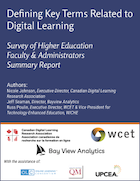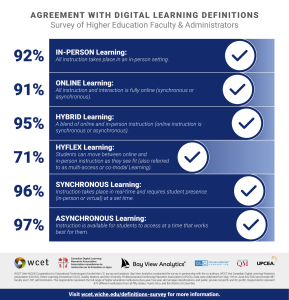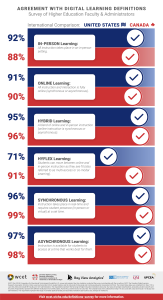Digital Learning Definitions
Higher education uses many variations of terms to describe slightly different digital learning modalities, such as: “in-person,” “online,” “hybrid,” “hyflex,” “synchronous,” “asynchronous,” and many more. These variations have long confused students, faculty, administrators, and the general public,
Bay View Analytics worked with the Canadian Digital Learning Research Association on a project sponsored by WCET to explore the use of the terms by higher education professionals. The Online Learning Consortium (OLC), Quality Matters (QM), and the University Professional and Continuing Education Association (UPCEA) assisted with survey participation and promotion.
Journal Article: Defining Different Modes of Learning
Defining Different Modes of Learning: Resolving Confusion and Contention Through Consensus
There has been longstanding contention about how terms related to online and hybrid learning should be defined. This study reports survey findings on how administrators and faculty apply the following terms in practice: online learning, hybrid learning, hyflex learning, in-person learning, synchronous learning, and asynchronous learning. Drawing upon the literature, the research team developed survey definitions for each of these terms. The survey then asked participants to rate the extent to which they agreed with the survey definitions.
The key finding from the study is that there was widespread agreement with the survey definitions, which is contrary to much of the literature that indicates confusion and contention about how online and hybrid learning terms should be defined. In light of the findings, we provide a framework for categorizing common learning modes and the variations that exist within these modes. This study provides a foundation for establishing common language and shared understandings as online and hybrid course offerings (and learning technologies, in general) continue to evolve.
A total of 987 faculty and 1,051 administrators participated in the study. Participants represented the full range of higher education institutions in the United States.
Download the Journal ArticleSummary Report: Defining Key Terms Related to Digital Learning
To address the ongoing debate about how terms related to online and hybrid learning should be defined, WCET (the WICHE Cooperative for Educational Technologies) funded a survey to explore the meanings of these terms. Dr. Jeff Seaman from Bay View Analytics conducted the survey and worked with Dr. Nicole Johnson to analyze the data. WCET and the researchers worked in partnership with the following organizations: the Canadian Digital Learning Research Association (CDLRA), Online Learning Consortium (OLC), Quality Matters, and the University Professional and Continuing Education Association (UPCEA).
The purpose of this report is to provide a brief overview of the findings from this study, which are described in detail in the article published in the Online Learning Journal.
Download Summary ReportWCET Webcast: Navigating the Confusing Array of Digital Learning Definitions
As students sign up for courses, they are faced with course delivery options such as online, remote, hybrid, hyflex, synchronous, and asynchronous – but how these are defined is not always clear, and they vary even within an institution and, sometimes, within a department. To understand the scale and nuances of the issue, WCET collaborated with Nicole Johnson Research and Consulting and Bay View Analytics to conduct an survey of digital learning faculty and staff. The Online Learning Consortium (OLC), Quality Matters (QM), and the University Professional and Continuing Education Association (UPCEA) helped distribute the survey and disseminate the results. Download presentation slides
Recorded session presentation
Podcast: Reliable “Buckets:” Toward Modality Clarity
Guest Dr. Nicole Johnson joins hosts Tom and Kelvin to discuss research on course modality definitions in Canada and the US and why clarity about course modalities is important for advancing the field of digital teaching and learning.
Listen to the podcastDownload the Podcast Transcript
INFOGRAPHIC - Agreement with Digital Learning Definitions
Infographic depicting each digital learning term, with a brief definition, and the percentage of survey respondents agreeing with that definition.
- In-person learning: All instruction takes place in an in-person setting. 92% agree.
- Online learning: All instruction and interaction is fully online (synchronous or asynchronous). 91% agree.
- Hybrid learning: A blend of online and in-person instruction (online instruction is synchronous or asynchronous). 95% agree.
- Hyflex learning: Students can move between online and in-person instruction as they see fit (also referred to as multi-access or co-modal learning). 71% agree.
- Synchronous learning: Instruction takes place in real-time and requires student presence (in-person or virtual) at a set time. 96% agree.
- Asynchronous learning: Instruction is available for students to access at a time that works best for them. 97% agree.
INFOGRAPHIC - Agreement with Digital Learning Definitions, International Comparisons
Infographic showcasing each digital learning term, a brief definition, and the percentage of survey respondents agreeing with that definition as broken down by surveys of U.S. respondents vs. Canadian respondents.
- In-person learning: All instruction takes place in an in-person setting. 92% agree for U.S. and 88% for Canada.
- Online learning: All instruction and interaction is fully online (synchronous or asynchronous). 91% agree for U.S. and 90% for Canada.
- Hybrid learning: A blend of online and in-person instruction (online instruction is synchronous or asynchronous). 95% agree for U.S. and 96% for Canada.
- Hyflex learning: Students can move between online and in-person instruction as they see fit (also referred to as multi-access or co-modal learning). 71% agree for U.S. and 91% for Canada.
- Synchronous learning: Instruction takes place in real-time and requires student presence (in-person or virtual) at a set time. 96% agree for U.S. and 99% for Canada.
- Asynchronous learning: Instruction is available for students to access at a time that works best for them. 97% agree for U.S. and 98% for Canada.
Recent Publications
Digital Learning Pulse Surveys
- Infographic: 2023-2024 Digital Learning Pulse Survey
- The Digital Transformation of the Community College
- Planning for a Smaller Future: Dealing with Declining Enrollments
Course Material Affordability
- Pennsylvania Course Materials Survey 2023
- Pennsylvania Course Materials Presentation
- Course Material Webinar Slides
Open Educational Resources
- Digitally Established: Educational Resources in U.S. Higher Education, 2023
- Curricula of Many Sources: Educational Resources in U.S. K-12, 2023
- Research Brief: Digital and OER Textbook Adoption
- Research Brief: Faculty Satisfaction with Course Materials varies by Publisher
STEM
- Teaching Online: STEM Education in the Time of COVID
- What Makes a STEM Student
- Perceptions of the Future of STEM Education
Distance Education
- Digital Faculty: Faculty Social Media Use and Communications
- Infographic: Digital Faculty
- Grade Increase: Tracking Distance Education in the United States
Follow us on
Privacy
All survey respondents are provided complete anonymity. No personally identifiable information is released. Full privacy policy.


